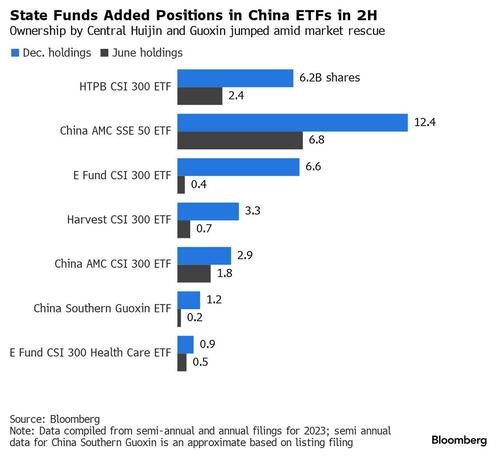By John Liu and April Ma, Bloomberg Markets Live reporters and strategists
A new dataset is giving China investors a peek into stock purchases by state-backed funds, promising to offer some clarity on the role played by them in supporting the world’s second-largest equity market in times of panic.
The so-called National Team bought at least 49 billion yuan ($6.8 billion) worth of onshore exchange-traded funds in the six months through Dec. 31, according to Bloomberg calculations based on the latest filings made available for the first time since state-backed funds announced the purchases last year. The amount exceeds an estimate of 28 billion yuan by Bloomberg Intelligence for such purchases.
While the data is available with a lag, it is seen giving investors a sense of Beijing’s resolve in aiding the market amid a selloff besides helping set future expectations. Analysts at Bloomberg Intelligence forecast China’s sovereign wealth funds and state insurance firms to buy about $100 billion in ETFs in 2024 after the CSI 300 Index, a benchmark of onshore equities, capped an unprecedented third straight annual loss last year.

"The figure serves as a reference as to what they did to try and prop up stocks last year," said Wu Xuan, fund manager at Borui Funds Management. It’s clear that the role of the national team is not to drive large rallies or systematically building stock positions, but to instead prevent steep plunges, he added. Hence, "plunge protection."
Purchases by state institutions such as sovereign wealth fund Central Huijin Investment and Guoxin Investment, which were active in the early part of 2024, slowed in March as the market rebounded. The CSI 300 ended the month little changed after a 9.4% surge in February that was the biggest since November 2022.
The ETFs that saw the biggest state buying in the second half were the Huatai-Pinebridge CSI 300 ETF and China AMC SSE 50 ETF, at nearly 13 billion yuan each, based on their lowest closing price during the period. That took Huijin’s holdings in the pair to 17% and 36%, respectively.
Meanwhile, Guoxin, a unit of China Reform Holdings, also added at least 831 million yuan of the China Southern CSI Guoxin Central-SOEs Technology Lead ETF, while also appearing as the second largest top holder of the Bosera CSI Central-SOEs’ Innovation Driven ETF.
“While normally there shouldn’t be intervention in the market, we will not hesitate to act when the market is severely divorced from its fundamentals and there is volatility driven by irrationality,” China’s top securities regulator Wu Qing said last month.
